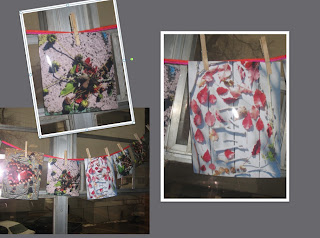Scroll to the bottom of the page and sign up to have KTEducation blog posts delivered via email every Thursday.
Lola is a fussy eater. She won't eat carrots or mashed potatoes and she especially won't eat tomatoes. Or will she?
Fruits and Vegetables: Use the book Growing Vegetable Soup by Lois Ehlert to discuss food groups, healthy eating and family celebrations. The simple but colorful artwork inspires cut paper art projects and monoprinting. For that all important Literacy connection combine art and writing to make books.
We Are Thankful: After a classroom brainstorming session on "things we are thankful for" set up the easel with paper, paints and aprons and have each student paint something they are personally thankful for. Gather the paintings and label them with what each student is thankful for, leaving off the beginning sound. For example: I am thankful for my __ amily (f). Display all the paintings on a magnetic white board and have the students add the missing beginning letter to each word with magnetic alphabet letters. At the end of the week, turn the easel paintings into a big book with a bag of alphabet letters included.
I Am Thankful: The brainstorming session can be extended into a writing/drawing activity. Have students trace their hands. On post it notes they draw/write about things they are thankful for. Students can also draw pictures and write sentences on the same topic. Cut the sentences apart, shuffle them and have students arrange the words to make the sentence. Paste to the paper with the drawings.
Corn Graphs: Taste testing items made from corn promotes discussion about items made from corn and the importance of corn to the Pilgrims. Graphs can also be used with the large group for counting and word problem lessons. This same type of taste test/graphing can be done with items made from apples such as apple chips, applesauce, apple juice, and raw apples.
Indian Corn Counting: Students glue the correct number of popcorn kernels in labeled shapes on construction paper corn patterns.
Veggie Prints: Have each child bring one vegetable from home and you'll have "plenty" for this art project. Cut vegetables in half, set out colored construction paper, bowls of colorful paint and let students print with a variety of vegetables. Set aside to dry. Have students cut a cornucopia (use a pattern) out of brown construction paper or have students draw a bowl or basket. Students cut out their veggie prints and paste them "into" the cornucopia or bowl. FYI: Green peppers look like shamrocks!
Set the Table: You'll need to gather quite a few materials, but once you do this activity is good to go! You'll need paper plates, plastic knives, forks and spoons (or a cardboard template of these) for each child. Also, supply paper napkins, construction paper, food magazines, a circle template for a glass and a diagram of the proper way to set the table. The last thing to do is cut lots and lots of different colored 1" squares. Have students use a 12" x 18" sheet of construction paper for their placemat. Using the colored squares they create a pattern and glue it all the way around the outside edge of the placemat. Using the diagram, students glue the plate, napkin and silverware onto the placemat. Then students cut out a healthy Thanksgiving meal from food magazines and paste the foods in place on their plates. All set for Thanksgiving!
 Design Rollers:
Design Rollers: While viewing
Native American art and discussing Native American culture, help students notice all the
patterns used in their pottery, baskets and bead work. Cardboard rolls ROCK and can be used to print on brown kraft paper or brown paper bags. Colored paper may also be used. There are many ways to recreate
patterns or make your own patterns for printing. Dip the roller ends in paint for a quick and easy way to add circles to your artwork. Manipulate the end of the tube into a heart or oval shape. Cover the cardboard roll with bubble wrap; add paint and you've got . . . polka dots! Randomly glue string or plastic wrap around the roll. Paint with one or more colors and print. Cut felt pads (Dr. Scholl's foot pads work great too!) into different shapes, glue on the cadboard roller and "roll" to create interesting patterns and designs. Cut the printed paper into bowl or basket shapes.

Alphabet Feast: Assign each student a letter of the alphabet and have them bring to school a food item to share beginning with that letter. Children make a headband with the letter that corresponds to the food item they brought for the feast. Use student made placemats and ENJOY! (Special thanks to Mary Brooks Thompson and Judy Jardine from Beacon Heights Elementary School in Salt Lake City, Utah.)
Family Tree: Great activity to do on the day the students retrun to school from Thanksgiving break. Students trace and cut out their handprints on green paper for each person who attended Thanksgiving dinner. Students turn their handprints into Evergreen trees. Perfect activity to bridge the gap between Thanksgiving and Christmas.
 The Snowflake: A Water Cycle Story by Neil Waldman
The Snowflake: A Water Cycle Story by Neil Waldman
















